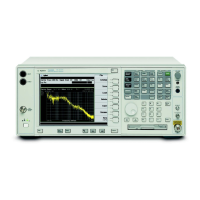Chapter 6 141
Troubleshooting the IF Section
Verifying the A7 Digital IF Board
Verifying the A7 Digital IF Board
This procedure assumes the A10 3rd Converter assembly and the A8
analog IF assembly are functioning correctly. To verify proper
functionality, refer to the “Verifying the A10 Third Converter Board
E4440A, E4443A, E4445A, E4446A, E4448A)” on page 129 and
“Verifying the A8 Analog IF Assembly Signal Path” on page 136.
Evaluating the performance of the digital IF board involves:
• measuring the input signal prior to the analog to digital conversion.
• verifying proper clock signals.
Digital IF Assembly Quick Check
The A7 digital IF assembly requires a 30 MHz clock from the A8 analog
IF assembly or the instrument will not boot.
1. Inject a −25 dBm, 50 MHz signal into the RF input of the
instrument.
2. Press
Preset on the instrument and tune to 50 MHz by pressing
Input, Input Port, RF, Frequency 50 MHz.
3. Press
Span, Zero Span.
4. Set the input attenuation to 10 dB. Press
Amplitude, Attenuation and
enter 10 dB.
5. Connect a calibrated spectrum analyzer to A7TP5 (for E4440-60025
or E4440-60195). If A7 is E4440-60206, connect to P202.
6. The 7.5 MHz IF power level at A7TP5 should measure
−21 dBm ±2 dB on the calibrated spectrum analyzer if the circuitry
up to the ADC is operating correctly.
7. Check the other ADC range settings by entering the service mode
and selecting each range.
8. Press
System, More, Service, -49, Enter, Service, More, Diagnostics, HW
Diag
On, ADC Range Manual.
ADC Range Power Level @ TP5 ±1 dB
0 dB −39 dBm
+6 dB −33 dBm
+12 dB −27 dBm
+18 dB −21 dBm
None N.A.

